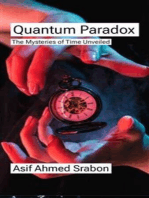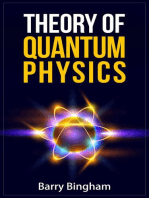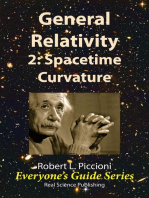0 ratings0% found this document useful (0 votes)
3 viewsString Vs Relativity Theory Explanation
String vs Relativity Theory
Uploaded by
nyeinchanmh2008Copyright
© © All Rights Reserved
Available Formats
Download as PDF, TXT or read online on Scribd
0 ratings0% found this document useful (0 votes)
3 viewsString Vs Relativity Theory Explanation
String vs Relativity Theory
Uploaded by
nyeinchanmh2008Copyright
© © All Rights Reserved
Available Formats
Download as PDF, TXT or read online on Scribd
You are on page 1/ 1
String theory and relativity theory are two of the most fundamental theories in physics, each
providing a unique perspective on the nature of reality.
Relativity theory is a well-established theory that describes gravity and its effects on
spacetime. It consists of two parts: special relativity and general relativity. Special relativity deals
with the motion of objects at high speeds, while general relativity deals with gravity and the
curvature of spacetime. Relativity theory has been extensively tested and is supported by
numerous experiments.
String theory is a relatively new and speculative theory that proposes that the fundamental
building blocks of the universe are not particles, but tiny, one-dimensional strings. These strings
can vibrate in different ways, giving rise to the different particles and forces we observe. String
theory is still being developed, and it has not yet been experimentally confirmed.
The main difference between string theory and relativity theory is their approach to
understanding the fundamental nature of reality. Relativity theory focuses on the macroscopic
world of gravity and spacetime, while string theory focuses on the microscopic world of particles
and forces. However, there is also a connection between the two theories. String theory can be
thought of as a quantum theory of gravity, which means that it provides a framework for
understanding gravity at the quantum level. This is something that relativity theory cannot do.
Ultimately, the question of which theory is correct is still an open one. Both string theory and
relativity theory have their strengths and weaknesses, and it is possible that both theories will
play a role in our understanding of the universe.
You might also like
- Quantum Physics For Beginners: Quantum Mechanics and Quantum Theory ExplainedFrom EverandQuantum Physics For Beginners: Quantum Mechanics and Quantum Theory ExplainedNo ratings yet
- Exploring the Interconnections Between String Theory, Multidimensional Reality, and Matter DisplacementFrom EverandExploring the Interconnections Between String Theory, Multidimensional Reality, and Matter DisplacementNo ratings yet
- Negative Mass and Negative Refractive Index in Atom Nuclei - Nuclear Wave Equation - Gravitational and Inertial Control: Part 1: Gravitational and Inertial Control, #1From EverandNegative Mass and Negative Refractive Index in Atom Nuclei - Nuclear Wave Equation - Gravitational and Inertial Control: Part 1: Gravitational and Inertial Control, #1No ratings yet
- 100 Scientific Concepts in 500 Words Each: In 500 words, #3From Everand100 Scientific Concepts in 500 Words Each: In 500 words, #3No ratings yet
- A Dynamical Theory of the Gravitational Field in a Connected Maxwell and Feynman Spacetime Continuum:On a Unified Field Theory of Space, Time and MatterFrom EverandA Dynamical Theory of the Gravitational Field in a Connected Maxwell and Feynman Spacetime Continuum:On a Unified Field Theory of Space, Time and MatterNo ratings yet
- The quantum postulate and the recent development of atomic theoryFrom EverandThe quantum postulate and the recent development of atomic theoryNo ratings yet
- The Future of the Impossible: The Physics and Ethics of Time TravelFrom EverandThe Future of the Impossible: The Physics and Ethics of Time TravelNo ratings yet
- The Singularities as Ontological Limits of the General RelativityFrom EverandThe Singularities as Ontological Limits of the General RelativityNo ratings yet
- Fundamentals of the General Theory of the UniverseFrom EverandFundamentals of the General Theory of the UniverseNo ratings yet
- Book Review: A Brief History of Time by Stephen Hawking: A summary of humanity’s study of the universeFrom EverandBook Review: A Brief History of Time by Stephen Hawking: A summary of humanity’s study of the universeNo ratings yet
- Think Physics: Beginner's Guide to an Amazingly Wide Range of Fundamental Physics Related QuestionsFrom EverandThink Physics: Beginner's Guide to an Amazingly Wide Range of Fundamental Physics Related QuestionsNo ratings yet
- Einstein: What is the Theory of Relativity?: Einstein's Essays on Relativity, Geometry, and Scientific Methods, #3From EverandEinstein: What is the Theory of Relativity?: Einstein's Essays on Relativity, Geometry, and Scientific Methods, #3No ratings yet
- The Mathematical Principles of Natural Philosophy: Newton's Mathematical Principles ExplainedFrom EverandThe Mathematical Principles of Natural Philosophy: Newton's Mathematical Principles ExplainedNo ratings yet
- Newton's Gravitation and Cosmic Expansion (III Observations)From EverandNewton's Gravitation and Cosmic Expansion (III Observations)No ratings yet
- A UNITARY THEORI OF NUCLEAR, ELECTROMAGNETIC AND GRAVITAIONAL FIELDSFrom EverandA UNITARY THEORI OF NUCLEAR, ELECTROMAGNETIC AND GRAVITAIONAL FIELDSNo ratings yet



























































